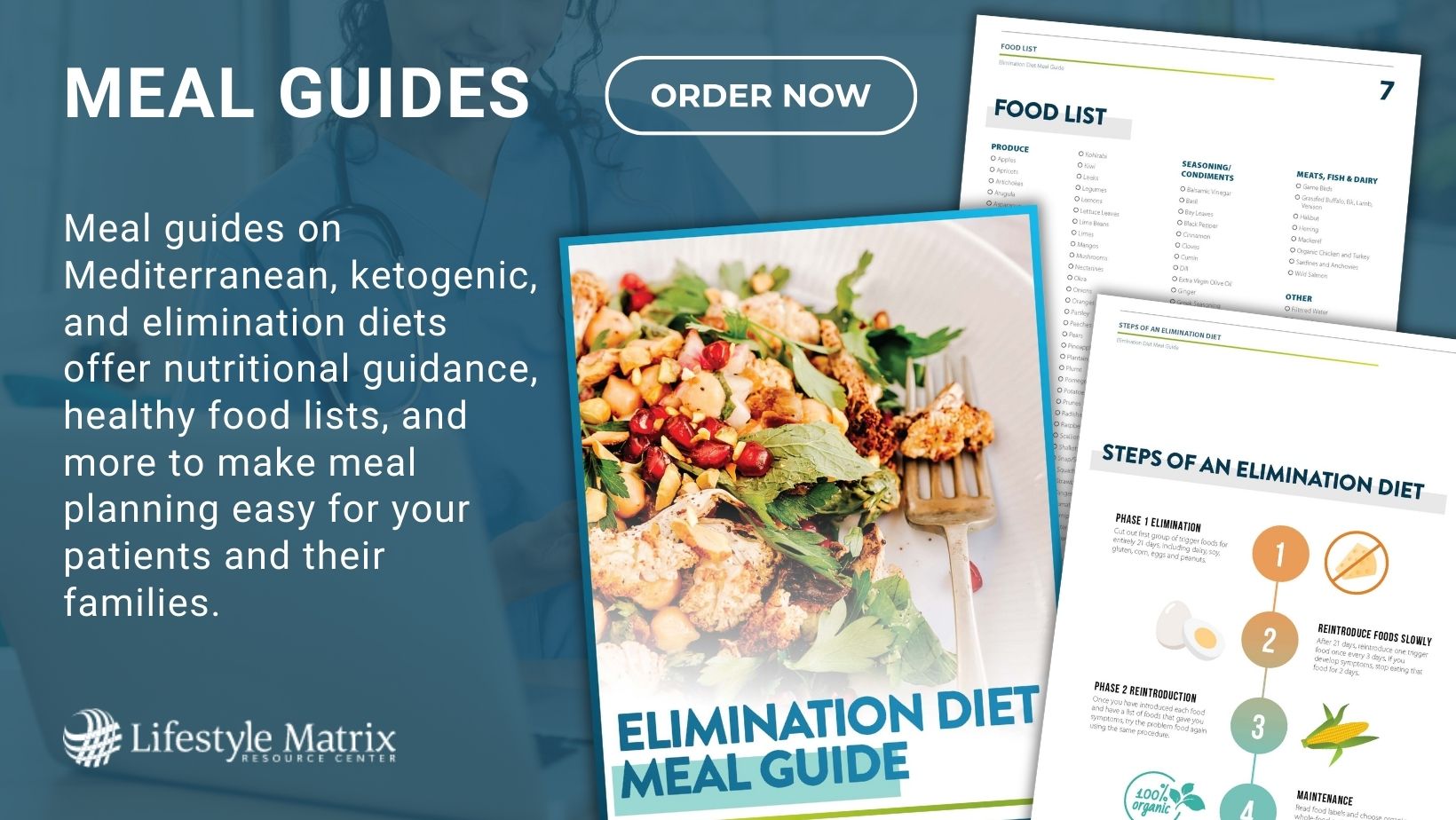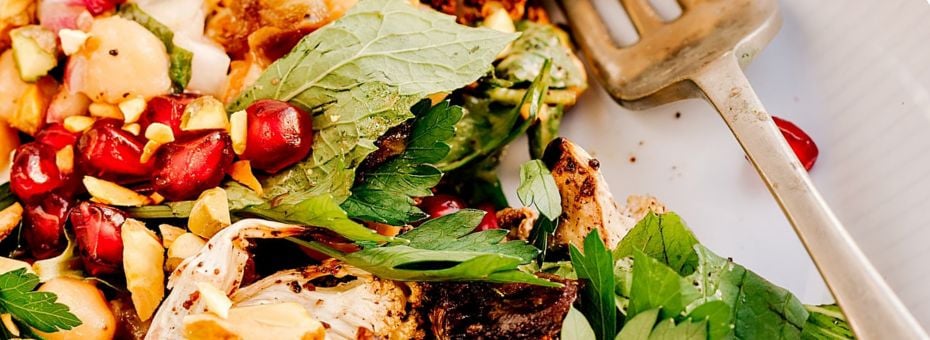When seeking to optimize biotransformation (detoxification) efficiency, nutrition needs to be a primary focus, and as such, the elimination diet is an essential part of your patient’s care plan.
The elimination diet is a powerful tool that reduces common allergens and inflammatory foods while promoting anti-inflammatory foods. In addition to aiding your patients in identifying inflammatory food triggers, it also provides the added benefit of reducing their daily intake of toxins found in processed foods (e.g., artificial coloring, pesticides, etc.). This, in turn, supports biotransformation by helping to restore gastrointestinal function, enhance mitochondrial energy production and balance inflammatory levels.
Key Elements of the Elimination Diet
The elimination diet involves eliminating foods that may be causing an immunological (allergy) or non-immunological (intolerance) reaction.1 Foods commonly avoided during the elimination diet are gluten, dairy, soy, eggs and nuts.2 These foods will be eliminated for a set period, typically two to six weeks, before being reintroduced one at a time.
Many patients are unaware that certain foods can trigger their symptoms. While obvious symptoms such as hives or anaphylaxis may not manifest, the body often responds in subtler ways, which may include fatigue, brain fog, hormonal fluctuations or unexplained weight gain.
During the reintroduction period, your patient may notice they have symptoms with specific foods and choose to avoid them long-term. This reintroduction period often serves as an eye-opening experience for patients, shedding light on how food impacts how they feel.
Enhancing Biotransformation with an Elimination Diet
It is important to note that the elimination diet does not restrict calories but instead promotes consuming foods rich in essential nutrients, such as fruits, vegetables, lean proteins and healthy fats. These foods support efficient biotransformation by supplying the necessary vitamins, minerals, essential fatty acids, fiber and phytonutrients.
Foods that Support Biotransformation
Fruits are best known for their high antioxidant and phytonutrient properties, which help reduce oxidative stress during biotransformation Phases I and II. Most fruits are high in water and fiber content, supporting digestion and helping to remove toxins through the digestive tract. Some fruits, such as pomegranate, lemons and limes, also support Phase III biotransformation by having alkalinizing effects on the body.
Vegetables are also high in phytonutrients and fiber. Cruciferous vegetables, such as broccoli, cabbage, cauliflower, brussels sprouts and kale, contain sulfur compounds that enhance Phase II liver biotransformation pathways and support toxin elimination. Similar to fruits, certain vegetables, such as leafy greens and watercress, have alkalinizing effects on the body, which also support Phase III elimination pathways.
Proteins are necessary for building and repairing tissues and provide the amino acids required for synthesizing specific enzymes crucial for Phase I (cytochrome P450) and Phase II (conjugation) biotransformation processes. Opting for clean protein sources, such as wild-caught fish, organic or pasture-raised poultry and grass-fed beef, can support the liver in its biotransformation functions.
Healthy fats provide essential fatty acids known for their anti-inflammatory properties, which play a crucial role in biotransformation by aiding in the modulation and reduction of oxidative stress levels. Encourage your patients to incorporate healthy sources of these fats, such as extra virgin olive oil, flaxseed oil, coconut oil and sunflower oil, into their daily diet unless contraindicated.
For additional information on foods that support biotransformation, please see Dr. Vincent Pedre’s blog post, “How to Help Your Patients Detoxify in a Modern World.”
Botanicals that Support Biotransformation
While the elimination diet serves as a fundamental step towards effective biotransformation, many patients often require professional-grade nutraceuticals and botanicals as supplementary support.
Key botanicals to consider include the following:
- Dandelion root is known to support liver and kidney health and increase the body’s bile production.3-5
- Artichoke supports liver health and bile production.6,7 In addition, it has positive effects on digestion.
- Milk thistle supports the liver and gallbladder. It is also helpful during biotransformation as it protects against glutathione depletion.8,9
- Garlic has many health-promoting properties, including the ability to support liver health. It has been shown to enhance the activity of glutathione S-transferase, thus improving biotransformation capabilities.10
Supporting the High Energy Demands of Biotransformation
Biotransformation is an energy-demanding process that can strain the body’s resources. The elimination diet supports the body by allowing energy to be redirected towards vital functions and enhancing mitochondrial biogenesis.11,12
Mitochondria, which generate most of the cellular supply of adenosine triphosphate (ATP), are abundant in the liver. Supporting mitochondrial health is essential for biotransformation because each hepatocyte (liver cell) contains 1,000 to 2,000 mitochondria, comprising approximately one-fifth of the total liver volume.13 Patients facing challenges like impaired mitochondrial function or a high toxic load can greatly benefit from additional mitochondrial support, including the use of professional-grade nutraceuticals.
Key nutrients required for mitochondrial health include the following:
- Acetyl L-carnitine, a form of L-carnitine, is an amino acid found in all living cells. Its primary role is to move long-chain fatty acids into the mitochondria, where such fatty acids undergo beta-oxidation to produce energy.14
- Alpha lipoic acid is a naturally occurring antioxidant in the body that helps to protect against oxidative stress.15 It also plays a crucial role in energy metabolism by acting as an enzymatic cofactor capable of generating energy and promoting mitochondrial biogenesis.16
- N-acetyl cysteine is the supplement form of cysteine, an amino acid found naturally in foods. It increases the production of glutathione, an important antioxidant utilized during biotransformation to break down and eliminate various waste products and toxins.17
- B vitamins support biotransformation through various metabolic pathways. They support mitochondrial function18 and promote methylation reactions,19 which are crucial for neutralizing harmful substances.

The Bottom Line
The elimination diet effectively enhances biotransformation efficiency while reducing toxin intake by focusing on clean sources of nutrient-rich foods like fruits, vegetables, lean proteins, and healthy fats. In addition, this dietary approach provides your patients with a newfound appreciation and understanding of how various foods affect their body’s responses and may contribute to their individual symptoms, thereby empowering them on their health journey.
Ryan VanBommel, DC is the Pillars of GI Health Brand Manager at Lifestyle Matrix Resource Center and a board-certified chiropractor in the state of Illinois. He obtained his doctorate in chiropractic from National University of Health Sciences in Lombard, Illinois. Passionate about functional medicine, he consistently strives to identify and tackle the root causes of health issues. Currently, Dr. VanBommel is pursuing his IFMCP certification from The Institute for Functional Medicine.
References
- Lopez CM, Yarrarapu SNS, Mendez MD. Food Allergies. 2023 Jul 24. In: StatPearls [Internet]. Treasure Island (FL): StatPearls Publishing; 2024 Jan. PMID: 29489188.
- Malone JC, Daley SF. Elimination Diets. [Updated 2024 Jan 9]. In: StatPearls [Internet]. Treasure Island (FL): StatPearls Publishing; 2024 Jan. Available from: https://www.ncbi.nlm.nih.gov/books/NBK599543/
- Pfingstgraf IO, Taulescu M, Pop RM, Orăsan R, Vlase L, Uifalean A, Todea D, Alexescu T, Toma C, Pârvu AE. Protective Effects of Taraxacum officinale L. (Dandelion) Root Extract in Experimental Acute on Chronic Liver Failure. Antioxidants (Basel). 2021 Mar 24;10(4):504. doi: 10.3390/antiox10040504. PMID: 33804908; PMCID: PMC8063808.
- Fan M, Zhang X, Song H, Zhang Y. Dandelion (Taraxacum Genus): A Review of Chemical Constituents and Pharmacological Effects. Molecules. 2023 Jun 27;28(13):5022. doi: 10.3390/molecules28135022. PMID: 37446683; PMCID: PMC10343869.
- Suljević D, Mitrašinović-Brulić M, Dervišević A, Fočak M. Protective role of the dandelion extract against the blood-liver axis, cell membranes, and anemia disorder in sodium benzoate-exposed rats. Cell Biochem Funct. 2022 Dec;40(8):946-958. doi: 10.1002/cbf.3756. Epub 2022 Oct 9. PMID: 36210509.
- Sonnenbichler J, Zetl I. Biochemical effects of the flavanolignane silibinin on RNA, protein and DNA synthesis in rat livers. In: Cody V, Middleton E, Harbourne JB, eds. Plant Flavonoids in Biology and Medicine: Biochemical, Pharmacological, and Structure-Activity Relationships. New York, NY; 1986:319-331.
- Kraft K. Artichoke leaf extract - Recent findings reflecting effects on lipid metabolism, liver and gastrointestinal tracts. Phytomedicine 1997 Dec;4(4):369-78.
- Bijak M. Silybin, a Major Bioactive Component of Milk Thistle (Silybum marianum L. Gaernt.)-Chemistry, Bioavailability, and Metabolism. Molecules. 2017 Nov 10;22(11):1942. doi: 10.3390/molecules22111942. PMID: 29125572; PMCID: PMC6150307.
- Campos R, Garido A, Guerra R, et al. Silybin dihemisuccinate protects against glutathione depletion and lipid peroxidation induced by acetaminophen on rat liver. Planta Med. 1989;55:417-419
- Wu CC, Chu YL, Sheen LY. Allicin modulates the antioxidation and detoxification capabilities of primary rat hepatocytes. J Tradit Complement Med. 2012 Oct;2(4):323-30. doi: 10.1016/s2225-4110(16)30118-3. PMID: 24716147; PMCID: PMC3942910.
- Khalil M, Shanmugam H, Abdallah H, John Britto JS, Galerati I, Gómez-Ambrosi J, Frühbeck G, Portincasa P. The Potential of the Mediterranean Diet to Improve Mitochondrial Function in Experimental Models of Obesity and Metabolic Syndrome. Nutrients. 2022 Jul 28;14(15):3112. doi: 10.3390/nu14153112. PMID: 35956289; PMCID: PMC9370259.
- Cherry AD, Piantadosi CA. Regulation of mitochondrial biogenesis and its intersection with inflammatory responses. Antioxid Redox Signal. 2015 Apr 20;22(12):965-76. doi: 10.1089/ars.2014.6200. Epub 2015 Feb 11. PMID: 25556935; PMCID: PMC4390030.
- An P, Wei LL, Zhao S, Sverdlov DY, Vaid KA, Miyamoto M, Kuramitsu K, Lai M, Popov YV. Hepatocyte mitochondria-derived danger signals directly activate hepatic stellate cells and drive progression of liver fibrosis. Nat Commun. 2020 May 12;11(1):2362. doi: 10.1038/s41467-020-16092-0. PMID: 32398673; PMCID: PMC7217909.
- Virmani MA, Cirulli M. The Role of l-Carnitine in Mitochondria, Prevention of Metabolic Inflexibility and Disease Initiation. Int J Mol Sci. 2022 Feb 28;23(5):2717. doi: 10.3390/ijms23052717. PMID: 35269860; PMCID: PMC8910660.
- Skibska B, Kochan E, Stanczak A, Lipert A, Skibska A. Antioxidant and Anti-inflammatory Effects of α-Lipoic Acid on Lipopolysaccharide-induced Oxidative Stress in Rat Kidney. Arch Immunol Ther Exp (Warsz). 2023 Jun 28;71(1):16. doi: 10.1007/s00005-023-00682-z. PMID: 37378741; PMCID: PMC10307712.
- Dos Santos SM, Romeiro CFR, Rodrigues CA, Cerqueira ARL, Monteiro MC. Mitochondrial Dysfunction and Alpha-Lipoic Acid: Beneficial or Harmful in Alzheimer's Disease? Oxid Med Cell Longev. 2019 Nov 30;2019:8409329. doi: 10.1155/2019/8409329. PMID: 31885820; PMCID: PMC6914903.
- Tenório MCDS, Graciliano NG, Moura FA, Oliveira ACM, Goulart MOF. N-Acetylcysteine (NAC): Impacts on Human Health. Antioxidants (Basel). 2021 Jun 16;10(6):967. doi: 10.3390/antiox10060967. PMID: 34208683; PMCID: PMC8234027.
- Janssen JJE, Grefte S, Keijer J, de Boer VCJ. Mito-Nuclear Communication by Mitochondrial Metabolites and Its Regulation by B-Vitamins. Front Physiol. 2019 Feb 12;10:78. doi: 10.3389/fphys.2019.00078. PMID: 30809153; PMCID: PMC6379835.
- Łoboś P, Regulska-Ilow B. Link between methyl nutrients and the DNA methylation process in the course of selected diseases in adults. Rocz Panstw Zakl Hig. 2021;72(2):123-136. doi: 10.32394/rpzh.2021.0157. PMID: 34114759.



